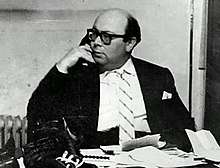Peter Rachman
| Peter Rachman | |
|---|---|
 | |
| Born |
Perec Rachman 1919 Lwów, Poland (modern Lviv, Ukraine) |
| Died |
29 November 1962 (aged 43) Edgware, London, England |
| Cause of death | Heart attack |
| Resting place |
Bushey Cemetery 51°39′23″N 0°21′02″W / 51.6565°N 0.3505°W |
| Nationality | Polish, later stateless |
| Occupation | Landlord, property developer |
| Spouse(s) | Audrey O'Donnell (1960–62, his death) |
| Military career | |
| Allegiance |
|
| Service/ | Polish Armed Forces in the West |
| Years of service | 1941–1948 |
| Unit | II Corps |
| Battles/wars | World War II |
Perec "Peter" Rachman (1919 – 29 November 1962) was a Polish-born landlord who operated in Notting Hill, London, England in the 1950s and early 1960s. He became notorious for his exploitation of his tenants, with the word "Rachmanism" entering the Oxford English Dictionary as a synonym for the exploitation and intimidation of tenants.
Early life and World War II
Rachman was born in Lwów, Poland, in 1919, the son of a Jewish dentist.[1] After the German invasion of Poland in 1939, Rachman may have joined the Polish resistance.[2] He was first interned by the Germans and, after escaping across the Soviet border, was reinterned in a Soviet labour camp in Siberia and cruelly treated.[3] After the Germans declared war on the Soviet Union in 1941, Rachman and other Polish prisoners joined the 2nd Polish Corps and fought on behalf of the Allies in the Middle East and Italy. After the war he stayed with his unit, which remained as an occupying force in Italy until 1946 when they transferred to Britain. Rachman was eventually demobilised in 1948 and became a British resident.[4]
Business career
Rachman began his career by working for an estate agent in Shepherd's Bush.[5] By 1957, he built up a property empire in west London consisting of more than one hundred mansion blocks and several nightclubs. His office was at 91–93 Westbourne Grove, in Bayswater, and the first house he purchased and used for multi-occupation was nearby in now-fashionable St. Stephen's Gardens, W2. In adjacent areas in Notting Hill (W11), including Powis Square, Powis Gardens, Powis Terrace, Colville Road and Colville Terrace, he also subdivided large properties into flats and let rooms, initially often for prostitution. Much of this area, south of Westbourne Park Road, having become derelict, was compulsorily purchased by Westminster City Council in the late 1960s and was demolished in 1973–74 to make way for the Wessex Gardens estate.[6][7]
According to his biographer, Shirley Green, Rachman moved the protected tenants into a smaller concentration of properties or bought them out to minimise the number of tenancies with statutory rent controls. Houses were also subdivided into a number of flats to increase the number of tenancies without rent controls.[8] He then filled the properties with recent immigrants from the West Indies. Rachman's initial reputation, which he even promoted in the media, was as someone who could help to find and provide accommodation for immigrants. However, some suggested he was overcharging these West Indian tenants, as they did not have the same protection under the law as had the previous tenants.
By 1958 he had largely moved out of slum-landlording into property development, but his former henchmen, including the equally-notorious Michael de Freitas (aka Michael X/Abdul Malik), who created a reputation as a black-power leader, and Johnny Edgecombe, who became a promoter of jazz and blues, helped to keep him in the limelight.[9][10] A special police unit was set up to investigate Rachman in 1959, and uncovered a network of 33 companies controlling his property empire.[5] They also discovered Rachman was involved in prostitution and he was prosecuted twice for brothel-keeping.[11]
Rachman did not achieve general notoriety until after his death, when the Profumo Affair of 1963 hit the headlines and it emerged that both Christine Keeler and Mandy Rice-Davies had been his mistresses, and that he had owned the mews house in Marylebone where Rice-Davies and Keeler had stayed.
As full details of his activities were revealed, there was a call for new legislation to prevent such practices, led by Ben Parkin, MP for Paddington North, who coined the term "Rachmanism". The subsequent Rent Act 1965 gave security to tenants.
Personal life
Rachman married his long-standing girlfriend Audrey O'Donnell in 1960 but remained a compulsive womaniser, maintaining Mandy Rice-Davies as his mistress at 1 Bryanston Mews West, W1, where he had previously briefly installed Christine Keeler. After suffering two heart attacks, Peter Rachman died in Edgware General Hospital on 29 November 1962, at the age of 43. He is buried in the Jewish cemetery at Bushey, Hertfordshire.[12]
Rachman was denied British citizenship. As his hometown was transferred from Poland to the Ukrainian Soviet Socialist Republic (part of the Soviet Union), he became stateless.[13]
References
- Citations
- ↑ Shirley Green Rachman, 1979, London: Michael Joseph, p. 7.
- ↑ Green, Rachman, p. 9.
- ↑ Green, Rachman, pp. 10–12.
- ↑ Green, Rachman, pp. 12–19.
- 1 2 "Peter Rachman". Virtual Museum: Famous/infamous residents. Royal Borough of Kensington and Chelsea. Retrieved 2 October 2016.
- ↑ British History Online – Paddington & Westbourne Green
- ↑ Flickr photo-set illustrating aftermath of Rachmanism in Westbourne Park area of London
- ↑ Green, Rachman, pp. 56–69.
- ↑ Getting it Straight in Notting Hill Gate, Tom Vague, 2007
- ↑ Notting Hill History Timeline,6: in the Ghetto, early 1950s
- ↑ "Infamous residents: Peter Rachman". Virtual Museum. Royal Borough of Kensington and Chelsea. Retrieved 1 July 2013.
- ↑ Green, Rachman, pp. 232–33.
- ↑ Green (1979), Rachman.
| Look up Rachmanism in Wiktionary, the free dictionary. |
- Bibliography